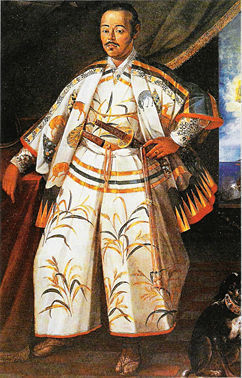The Story of Hasekura Tsunenaga
First Japanese official to establish trade relations between Japan and Europe

Who was Hasekura Tsunenaga?
Hasekura Rokuemon Tsunenaga (born 1571, died August 7, 1622) was a Japanese samurai who served the daimyo of the Japanese city of Sendai, Date Masamune. He led a diplomatic mission to Mexico and then to Europe between 1613 and 1620, finally returning to Japan.
He was the first Japanese official sent to America and his trip to France became the first recorded instance of direct contact in Franco-Japanese relations.
In order to establish a commercial relationship and request the sending of Christian missionaries, the founder of Sendai, Date Masamune, sent in 1613 a mission to Europe embarked on the "Saint John the Baptist", a Western-style sailing ship built by the Sendai manor. The name of his Subdelegate was Haskura Tsunenaga, a vassal of Masamune, who disembarked first in the city of Acapulco (Mexico) crossing the Pacific Ocean, with a Spanish galleon, and then headed for Europe, arriving on December 20, 1614.
He visited Madrid (Spain) and Rome (Italy) becoming the first Japanese to cross the Atlantic Ocean.
The Japanese mission commanded by Hasekura, had an audience with King Philip III of Spain, on January 30, 1615, and brought him a letter from Date Masamune offering him a treaty. The King replied that he would do his best to fulfill his requests.
In Italy, the mission was granted an interview with the Supreme Pontiff. His long journey ended almost seven years after he departed from Japan. This is one of the most relevant events in the history of the populous Japanese city of Sendai.
The Japanese ambassador, Hasekura, was baptized on February 17 by the staff of the Spanish royal chaplaincy with the new name of Felipe Francisco Hasekura.
The mission left Seville for Mexico in June 1617 after two years in Europe, but it was here that some Japanese decided to stay in Spain, specifically in the Sevillian town of Coria del Río, where their descendants still retain the surname "Japón".
The symbiosis with Spain
At present, there are many citizens in the city of Coria del Rio, who not only have the adopted surname "Japan" as a legacy passed down from those first Japanese who decided to stay in the town, but it is not difficult to guess in them certain features that corroborate their Japanese descent.
The prestigious researcher, poet and novelist from Coria, Daniel Pineda Novo, a great connoisseur of this subject, assures that the main reason that pushed these navigators to put down roots in this city was none other than the charm of the beautiful women they found and the open and hospitable character offered by its inhabitants.
At that time, Coria del Río, in addition to being a society with a basically agricultural economy, lived manifestly turned to the river and the fruits that it offered to its community, being an important fluvial and commercial port on the Guadalquivir, a reason that must have served as a channel for the fusion of both cultures.
Nowadays, we can affirm that the Corian today is fully aware of the bond that unites him with the Japanese people. He knows that many of his neighbors share the same blood and recognize the figure of the Japanese ambassador Haskura as the catalyst of this peculiar relationship. Since it was discovered, the City Council has ensured respect and increased bilateral cultural relations with the Japanese government, through the figure of its ambassador to Spain.